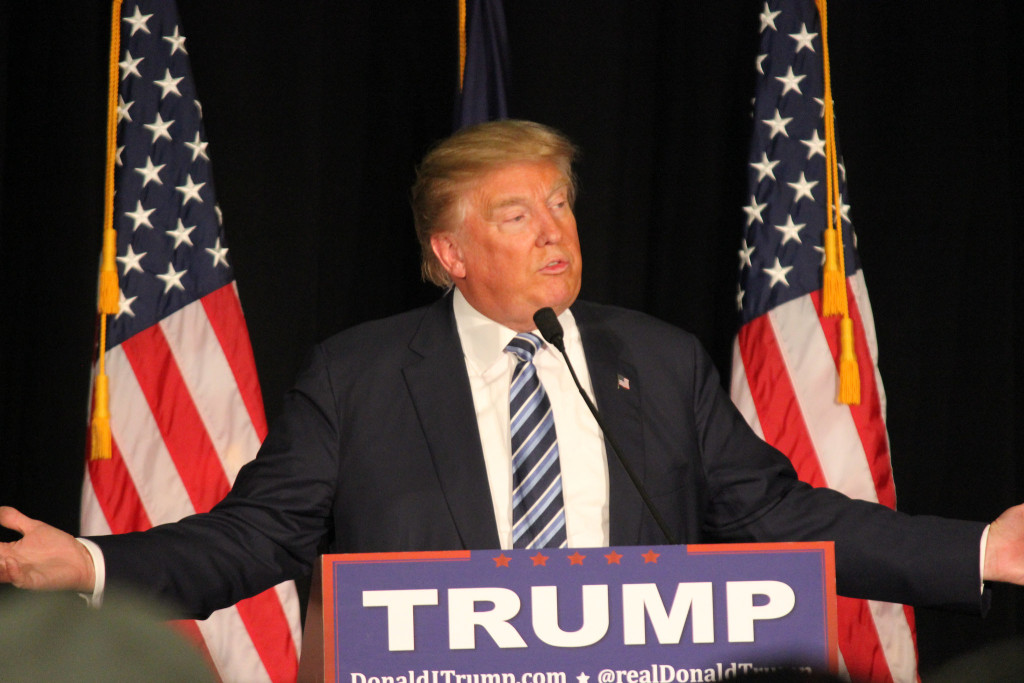
Donald Trump speaks at a December 2015 campaign stop at Mid-America Center in Council Bluffs, Iowa. According to new research, Trump found significantly more support in areas with high drug, alcohol and suicide mortality rates during the 2016 Presidential election. Photo Credit: Matt A.J./Flickr
UNIVERSITY PARK, Pa. — President-elect Donald Trump found significantly more support in areas with high drug, alcohol and suicide mortality rates during the 2016 Presidential election, according to a Penn State rural sociologist and demographer.
Economic factors seem to explain most of the relationship between Trump’s success and drug, alcohol and suicide deaths — or deaths of despair — in these areas, said Shannon Monnat, assistant professor of rural sociology, demography and sociology.

Shannon Monnat
“Counties that once had strong manufacturing and extraction industries, but then experienced significant decline in those industries over the past three decades are areas that have higher rates of deaths of despair,” said Monnat. “Trump also overperformed most in these types of counties.”
Trump garnered more support in many areas where former Republican presidential contender Mitt Romney struggled against President Barack Obama in the 2012 campaign. He outperformed Romney in 2,469 of the 3,106 counties included in the study. He did better than Romney in 89 percent of counties in the Industrial Midwest, 91 percent of counties in Appalachia and 69 percent of counties in New England.
These regions also have high and increasing rates of death of despair, Monnat added. Nationally, the average drug, alcohol and suicide mortality rate is 36 deaths per 100,000 in the least economically distressed counties and 49 deaths per 100,000 in the most economically distressed counties. In the Industrial Midwest, there were an average of 16.3 deaths per 100,000 more in the most economically distressed counties compared to counties in that region that were least economically distressed and in Appalachia, there were more than 13 deaths per 100,000 more in the most economically distressed counties than in the least economically distressed counties. The most economically distressed counties in New England had an average of 10 deaths per 100,000 more than the least economically distressed counties.
Trump’s anti-free trade and anti-immigration rhetoric seemed to resonate best with people living in those areas, even though Obama carried many of those areas in the prior Presidential election.
“It’s not that these types of mortality, in and of themselves, are driving an increased share of votes for Trump, but that they are underlying more systemic economic and social problems in these counties,” said Monnat. “A large share of this relationship nationally is explained by economic factors like economic distress and large concentrations of working class voters.”
Economic distress is a composite index of six economic factors, including the adult poverty rate, the unemployment rate, the disability rate, the percentage of families with children headed by a single parent, the percentage of households receiving public assistance and the percentage of adults age 18-64 without health insurance.
Economic distress and the presence of working class voters explained about 44 percent of the relationship between deaths of despair and Trump support nationwide, but it explained much more of the relationship in these specific regions, according to Monnat.
“I think Trump’s anti-free trade message resonated in these places and his rhetoric was very simple — Make America great again,” said Monnat. “And you have to understand that in some of these places that have experienced widespread decline in manufacturing and extraction and the types of jobs that pay livable wages, people there really feel like America is not so great anymore. I think the message that he was the change candidate really resonated with people in these places.”
Monnat, who released her findings online in a working paper, used data from the Atlas of U.S. Presidential Elections and the Centers for Disease Control and Prevention.





